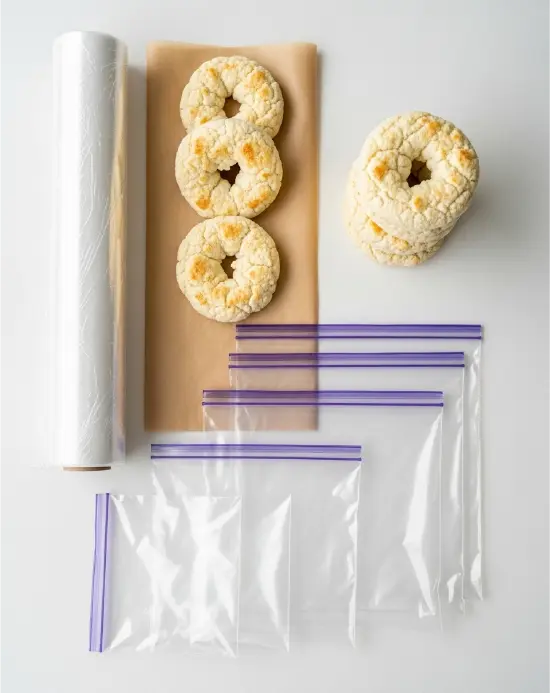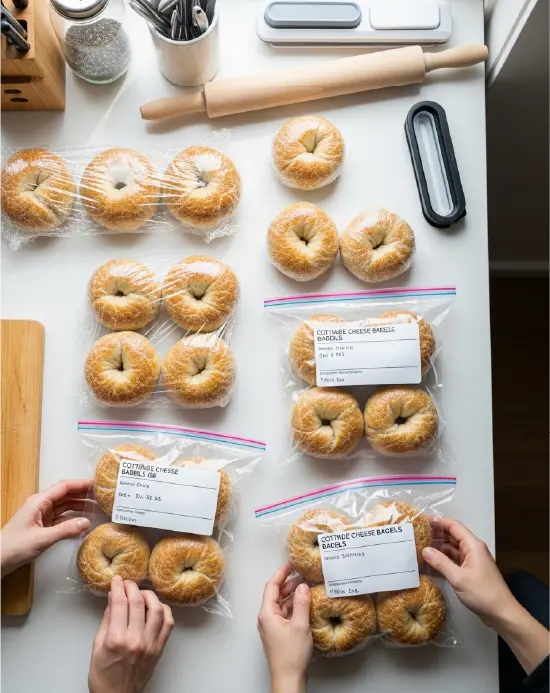There’s something about the smell of warm cottage cheese bagels that pulls me right back to my grandmother’s kitchen in spring. She always said, “Don’t waste a crumb,” and with five hungry grandkids running around, leftovers didn’t last long. But in my own house, we often make a double batch—and then life happens. That’s when I started looking into how to freeze cottage cheese bagels without ruining their soft texture or creamy flavor.
Turns out, if you freeze them wrong, they come out dry, soggy, or even freezer-burned. But with the right steps, you can make a batch now and enjoy perfect bagels days—or even weeks—later. In this guide, I’ll show you exactly how to freeze cottage cheese bagels the right way: no sogginess, no rubbery texture, just real flavor and freshness every time.
Note Before You Try
This freezing guide is based on personal experience and general kitchen research. It’s not intended as professional food safety advice. If you have dietary restrictions or health concerns, please consult a qualified expert. Results may vary depending on storage methods and ingredients used.
Understanding Freezing Cottage Cheese Bagels
Why freezing works (and where it can go wrong)
Cottage cheese bagels are a little different from standard bagels. That creamy, protein-rich base adds moisture, which makes them softer and chewier than most. But that moisture is also why freezing cottage cheese bagels incorrectly can lead to a soggy mess.

Freezing works best when moisture is sealed inside and air is locked out. When you know how to freeze cottage cheese bagels properly—cool, wrap tight, and freeze fast—they stay as good as the day they were baked.
Room temp, fridge, or freezer: What’s best?
Refrigerating cottage cheese bagels isn’t a great idea. Bagels stored in the fridge go stale quickly and lose their signature chew. If you’re not eating them within 24 hours, it’s smarter to freeze them right away.
For the full bagel recipe, check out our Cottage Cheese Bagel Recipe.
That’s why it’s essential to know how to freeze cottage cheese bagels the right way, so you don’t waste a single one. Whether you’re saving time on weekday breakfasts or batch-cooking for later, this method works every time.
Prepping Bagels Before Freezing (Don’t Skip These Steps)
The best way to slice your cottage cheese bagels before freezing
Let’s start with a key trick: always slice your bagels in half before freezing them. Not only does it help them freeze more evenly, but it makes it so much easier to pop them into the toaster straight from the freezer. Trying to cut a frozen bagel? That’s a recipe for disaster—and possibly a bent knife.
If you’re working with a fresh batch of homemade dough, wait until they’ve cooled completely before slicing. Warm bagels are still releasing steam, and if you trap that steam in a bag too soon, you’ll end up with soggy middles and freezer burn. Nobody wants that.

Knowing how to freeze cottage cheese bagels starts with getting the prep right. Once your bagels are sliced, you can portion them for individual servings or keep them paired, depending on how you plan to thaw and eat them later.
Why cooling completely makes all the difference
It’s tempting to freeze bagels right out of the oven—but don’t do it. Freezing warm bagels locks in steam, which turns into ice crystals. And ice crystals are the enemy of a chewy, soft texture.
Instead, let your cottage cheese bagels rest on a cooling rack for at least 1–2 hours. This step helps reduce moisture buildup and protects your bagels from going stale or mushy in the freezer. Need help making your bagels from scratch? Check out our Cottage Cheese Bagel Recipe for a foolproof starter batch.
Now that you’ve sliced and cooled them correctly, you’re halfway to mastering how to freeze cottage cheese bagels without ruining their texture. Next up: wrapping, bagging, and freezing like a pro.
Freezing Cottage Cheese Bagels Properly (Wrap, Bag, and Freeze the Right Way)
Best wrapping materials for freezing
Once your cottage cheese bagels are sliced and completely cool, it’s time to wrap them. This step matters just as much as baking them right. To keep them fresh and avoid freezer burn, use a layer of plastic wrap or parchment paper directly against the surface of each bagel half. Then place them inside a resealable freezer bag or an airtight container.

If you’re freezing multiple bagels, wrap them individually before storing together. That way you can take out just what you need without exposing the rest to air.
Avoid using only foil or wax paper—they don’t fully seal out air or moisture. The goal is to freeze your cottage cheese bagels in a way that prevents flavor loss and ice crystal buildup, and plastic wrap or a tight freezer bag makes a big difference.
Should you flash freeze first?
Yes—if you have time, flash freezing helps! Arrange your sliced and cooled bagels in a single layer on a parchment-lined baking sheet. Place the tray in the freezer for 1–2 hours, or until the bagels are firm to the touch. Then wrap and store them in your freezer-safe bag or container.
This technique keeps them from sticking together and makes it easier to grab just one or two at a time. If you’re planning freezer breakfasts or lunch prep, flash freezing gives you flexibility and saves time down the line.
Flash freezing also keeps your cottage cheese bagels from absorbing excess moisture while they settle. When you’re learning how to freeze cottage cheese bagels properly, this step can be the difference between a fresh, chewy bite and a disappointing, mushy one. For baking tips that pair perfectly with freezing advice, explore our Cottage Cheese Bagel Recipe.

Once packed, label the bag with the date. For best texture and flavor, use within 2–3 months. They’ll last longer, but the quality may start to fade after that window.
Thawing Cottage Cheese Bagels Without Sogginess (Plus Your Top Questions Answered)
How to thaw frozen cottage cheese bagels the right way
The best way to thaw frozen cottage cheese bagels? Just leave them on the counter for about 30 minutes. That’s enough time to bring them back to room temperature without turning them rubbery. Once they’ve softened, a quick toast brings back the crisp edges and warm, chewy middle.
If you’re in a rush, you can skip the thawing altogether. Just place your frozen, pre-sliced bagel straight into the toaster or toaster oven. Keep the setting on low-to-medium so the outside doesn’t burn before the inside is warm. This method works especially well if you followed the earlier tips on how to freeze cottage cheese bagels properly—slice first, wrap well, freeze fast.
Avoid microwaving unless you’re in a pinch. It often makes bagels chewy in the worst way and can unevenly heat the cheese.
FAQs About How to Freeze Cottage Cheese Bagels
Can you freeze cottage cheese bagels?
Yes, absolutely. As long as they’re cooled, wrapped, and sealed correctly, cottage cheese bagels freeze beautifully. Their soft texture and slightly creamy crumb hold up well for 2–3 months in a standard freezer.
Do cottage cheeses freeze well?
On their own, cottage cheeses can separate or become grainy when frozen. But inside a baked dough like a bagel, they actually retain their moisture nicely. So while you wouldn’t freeze a tub of cottage cheese, you can freeze cottage cheese bagels with no problem.
Can you freeze cottage cheese bread?
Yes. Like bagels, breads made with cottage cheese freeze best when fully cooled and well-wrapped. Slice before freezing for easy portions. Just like learning how to freeze cottage cheese bagels, the same principles apply here—cool, wrap, seal, label.
How to freeze bagels so they stay fresh?
To keep bagels fresh, slice them first, wrap them tightly in plastic wrap or parchment, and place them in a resealable freezer bag. Label with the date, and be sure to use them within a couple of months. This method applies to all bagels, but especially those made with soft dairy-based doughs like cottage cheese bagels.
So if you’re wondering how to freeze cottage cheese bagels without ending up with soggy crusts or freezer-burned centers, the answer is clear: slice, cool, wrap, seal, and store right.
Conclusion
Freezing cottage cheese bagels doesn’t have to feel like a gamble. With a few simple tricks—cool completely, slice first, wrap tightly—you can enjoy homemade goodness even on your busiest mornings. And once you master how to freeze cottage cheese bagels without losing flavor or texture, you’ll never toss a leftover again.
Want to bake your own batch from scratch? Don’t miss the Cottage Cheese Bagel Recipe, it’s the one I use every weekend.
And for even more daily inspiration, follow us on Facebook at Golden Era Recipes—where wholesome food meets everyday life.





